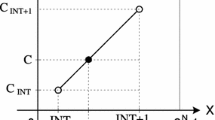Abstract
This paper describes algorithms for generating a low-distortion single-tone signal, for testing ADCs, using an arbitrary waveform generator (AWG). The AWG consists of DSP (or waveform memory) and DAC, and the nonlinearity of the DAC generates distortion components. We propose here to use DSP algorithms to precompensate for the distortion. The DSP part of the AWG can interleave multiple signals with the same frequency but different phases at the input to the DAC, in order to precompensate for distortion caused by DAC nonlinearity. Theoretical analysis, simulation, and experimental results all demonstrate the effectiveness of this approach.

















Similar content being viewed by others
References
Arabi K (2010) Mixed-signal test impact to SoC commercialization. In: IEEE VLSI test symposium
Burns M, Roberts GW (2000) An introduction in mixed-signal IC test and measurement. Oxford Univ Press
Cheng K-T, Chang H-M (2010) Recent advances in analog, mixed-signal and RF testing. IPSJ trans on system LSI design methodology, vol 3, pp 19–46
Cripps SC (1999) RF power amplifier for wireless communications. Artec House, pp 263–267
Cripps SC (2002) Advanced techniques in RF power amplifier design. Artec House, pp 153–195
Kurosawa N, Kobayashi H, Maruyama K, Sugawara H, Kobayashi K (2001) Explicit analysis of channel mismatch effects in time-interleaved ADC systems. IEEE Trans Circuits Syst I 48(3):261–271
Maeda A (2008) A method to generate a very low distortion, high frequency sine waveform using an AWG. In: IEEE international test conference, Santa Clara, CA
Maloberti F (2007) Data converters. Springer
Plassche R (2003) CMOS integrated analog-to-digital and digital-to-analog converters, 2nd edn, Chapters 1, 4 and 6. Kluwer Academic Publishers, Boston
Shrestha R, Mensink E, Klumperink EAM, Wienk GJM, Nauta B (2006) A multi-path technique canceling harmonics and sidebands in a wideband power upconverter. In: Tech digest of IEEE international solid-state circuits conference, San Francisco
Uemori S, Yamaguchi TJ, Ito S, Tan Y, Kobayashi H, Takai N, Niitsu K, Ishikawa N (2010) ADC linearity test signal generation algorithm. In: IEEE Asia Pacific conference on circuits and systems, Kuala Lumpur
Wakabayashi K, Yamada T, Uemori S, Kobayashi O, Kato K, Kobayashi H, Niitsu K, Miyashita H, Kishigami S, Rikino K, Yano Y, Gake T (2011) Low-distortion single-tone and two-tone sinewave generation algorithms using an arbitrary waveform generator. In: IEEE international mixed-signals, sensors and systems test workshop, Santa Barbara, CA
Yagi T, Kobayashi H, Tan Y, Ito S, Uemori S, Takai N, Yamaguchi TJ (2010) Production test consideration for mixed-signal IC with background calibration. IEEJ Trans on Electrical and Electronic Eng 5(6):651–659
Yamada T, Kobayashi O, Kato K, Wakabayashi K, Kobayashi H, Matsuura T, Yano Y, Gake T, Niitsu K, Takai N, Yamaguchi TJ (2011) Low-distortion single-tone and two-tone sinewave generation using ΣΔ DAC. In: IEEE international test conference (poster session), Anaheim, CA
Acknowledgments
We would like to thank T. Matsuura, N. Takai, Y. Yano, T. Gake, T. J. Yamaguchi, H. Miyashita, S. Kishigami, K. Rikino, S. Uemori and K. Wilkinson for valuable discussions.
Author information
Authors and Affiliations
Corresponding author
Additional information
Responsible Editor: H.-M. Chang
Appendix
Appendix
This appendix describes the explicit power spectrum of the DAC output Y(nT s ) for the simultaneous cancellation algorithm of HD3 and HD2 in Section 4.1. Equation 14 can be written as follows:
Here \(W = \exp (j \pi/2)\). Then explicit Y(nT s ) can be obtained from Eqs. 16, 17 and 21 as follows:
We see that 2 f in, 3 f in components are cancelled in Y(nT s ).
Rights and permissions
About this article
Cite this article
Wakabayashi, K., Kato, K., Yamada, T. et al. Low-Distortion Sinewave Generation Method Using Arbitrary Waveform Generator. J Electron Test 28, 641–651 (2012). https://doi.org/10.1007/s10836-012-5293-4
Received:
Accepted:
Published:
Issue Date:
DOI: https://doi.org/10.1007/s10836-012-5293-4




